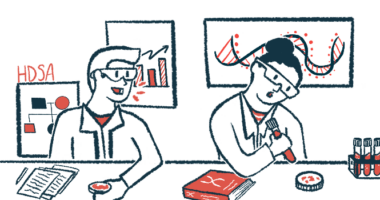Protein May Help Prevent Nerve Cell Death in Huntington’s Disease

Researchers have found a protein, called UBR5, that may reduce neurodegeneration in Huntington’s disease (HD).
This protein prevents the toxic aggregation (clustering) of mutant huntingtin protein, which is the underlying mechanism that triggers nerve cells’ death in Huntington’s patients.
The study, “The ubiquitin ligase UBR5 suppresses proteostasis collapse in pluripotent stem cells from Huntington’s disease patients,” was published in the journal Nature Communications.
Huntington’s is a fatal neurodegenerative disorder characterized by cognitive deficits, psychosis and motor dysfunction. The disease is caused by mutations in the huntingtin (HTT) gene. Specifically, these mutations lead to an expansion of three nucleotides (DNA building blocks), called CAG. As a result, the mutant huntingtin protein is much longer than its normal version.
This mutant protein is cut into smaller toxic pieces, which stick together and accumulate inside nerve cells. This results in abnormal cell function and eventually death.
Induced pluripotent stem cells (iPSC) from Huntington’s patients are capable of avoiding the toxic accumulation of mutant huntingtin protein aggregates, even though they carry the mutated HTT gene. iPSC cells are pluripotent stem cells similar to the stem cells found in embryos, which means they can self-renew and give rise to all cell types in the body, including nerve cells.
This suggests that somehow these cells have a mechanism that blocks the accumulation of toxin protein aggregates, the ultimate driver of nerve cell death.
Researchers at the University of Cologne’s Cluster of Excellence for Aging Research (CECAD) found that HD-iPSCs have a higher activity of a protein degradation machine, called the proteasome. Inhibiting the proteasome activity in iPSCs derived from two individuals with juvenile-onset Huntington’s disease and from an individual with adult-onset Huntington’s disease reverted the cells’ “protective” profile, and led to a high percentage of mutant huntingtin aggregation.
These pluripotent stem cells had particularly higher levels of the UBR5 protein, compared to mature nerve cells. Higher UBR5 levels in Huntington’s iPSCs contributed to the degradation of the huntingtin protein by the proteasome. As such, decreasing UBR5 levels immediately induced an increase in the levels of huntingtin protein aggregates.
“This was striking to see”, David Vilchez, PhD, study lead author said in a press release. “From nothing, the cells went to huge amounts of aggregates.”
UBR5 was identified as a specific regulator of huntingtin protein levels, as decreasing the levels of other proteins in the proteasome machinery had no affect in the aggregation pattern of the huntingtin protein.
The team also used a Huntington’s model organism, a worm called Caenorhabditis elegans, that expresses a mutant form of the huntingtin protein.
Decreasing the levels of the UBR5 protein in a Huntington’s model organism, a worm called Caenorhabditis elegans, also led to a higher and more rapid aggregation of mutant huntingtin in the animal’s nerve cells. Loss of UBR5 accelerated the worm’s loss of mobility.
Importantly, increasing UBR5 protein levels in human cells suppressed mutant huntingtin protein aggregation.
“Our result is very specific to Huntington’s disease,” said study author Isabel Saez, PhD.
Although there is still no therapy available, these preclinical results may be a step closer for future treatment and drug development. “It’s not like you discover something new and then there is a cure, it’s more difficult – but in some years there might be a therapy,” Saez said.






